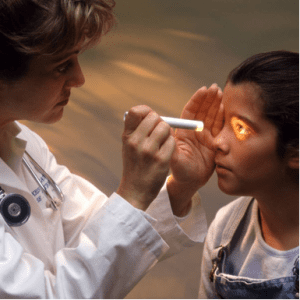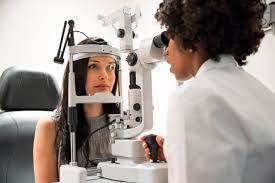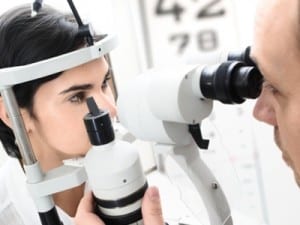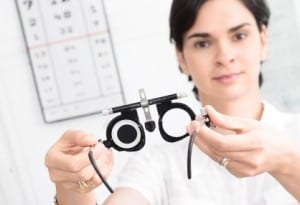As with all medicine, early diagnosis and treatment can help people with their overall health. Just as with a physical, it makes sense to visit an Optometrist regularly for a routine eye exam. A series of tests will be performed to assess acuity, refraction and screening for potential eye disease.
Your Optometrist at Malaya Optical in Damansara Uptown will begin by asking a series of questions about your medical and eye health history, including any noticeable eye problems. Next they will evaluate your visual acuity by determining the smallest letters you can read on a standardized eye chart. This would determine your visual acuity. Please ask them about Visual Acuity (VA) when your with them 😉
The Optometrist would also test for refractive errors. A refractive error means that the shape of your eye doesn’t refract the light properly, so that the image you see is blurred. Although refractive errors are called eye disorders, they are not diseases.
There are four types of refractive error:
- Myopia (nearsightedness): Close objects look clear, but distant objects appear blurred.
- Hyperopia (farsightedness): Where distant objects will look clear but close objects are blurry
- Astigmatism: Vision is blurred for both near and far objects.
- Presbyopia: The eyes gradually lose the ability to change focus from distance to near.
Many people will have one or more of these refractive errors.
To correct a refractive error, our Optometrist in Petaling Jaya may recommend glasses, contact lenses, or refractive surgery.

In addition, an Optometrist if necessary will test for:
- Eyelid health and function
- Coordination of eye muscles
- Pupil response to light
- Intraocular pressure, the pressure inside the eye via Non Contact Tonometer
- Anterior segment of the eye, the area in from of the lens, including the cornea and iris via Slit Lamp Camera
- The interior and back of the eye, including the retina via Fundus Camera
After the examination your Optometrist will discuss the results with you. If there is any eye disease, treatments with medication, including eye drops, may be recommended.
In some cases, certain eye diseases require laser surgery or other surgical procedures. Some of the treatments are would be referred to an Eye Doctor or, you may be referred to a subspecialist, such as a cornea or retina specialist.
Recommended Intervals for Regular Eye Exams
If you have any of these risk factors for eye problems, you may need to see your Optometrist more often than recommended below:
- Family history of eye problems
- Diabetes
- History of eye injury
Age 5 to 19
To ensure your child or teenager’s eyes remain healthy, he or she should have his or her eyes screened every one to two years during regular Optometrist Pediatric check-up appointments.
- Strabismus (crossed eyes)
- Amblyopia (lazy eye)
- Ptosis (drooping of the upper eyelid)
Age 20 to 39
Most young adults have healthy eyes, but they still need to take care of their vision by wearing protective eyewear when playing sports, doing yard work, working with chemicals, or taking part in other activities that could cause an eye injury.
Have a complete eye exam at least once between the ages of 20 and 29 and at least twice between the ages of 30 and 39.
Also, be aware of symptoms that could indicate a problem.
- Visual changes or pain
- Flashes of light
- Seeing spots or ghost-like images
- Lines appear distorted or wavy
- Dry eyes with itching and burning
Age 40 to 64
As of July 2007, the American Academy of Ophthalmology has issued a new eye disease screening recommendation for aging adults.
The Academy now recommends that adults with no signs or risk factors for eye disease get a baseline eye disease screening at age 40—the time when early signs of disease and changes in vision may start to occur.
For individuals at any age with symptoms of or at risk for eye disease, such as those with a family history of eye disease, diabetes or high blood pressure, the Academy recommends that individuals see their Optometrist or ophthalmologist to determine how frequently their eyes should be examined.
Why the New Recommendation?
A baseline evaluation is important because it may detect eye diseases common in adults aged 40 and older. The evaluation creates greater opportunity for early treatment and preservation of vision.
A thorough Optometric evaluation can uncover common abnormalities of the visual system and related structures, as well as less common but extremely serious ones, such as ocular tumors. This evaluation can also uncover evidence of many forms of systemic disease that affect the eyes, like hypertension and diabetes. With appropriate intervention, potentially blinding diseases such as glaucoma, cataract and diabetic retinopathy often have a favorable outcome.
Several common eye diseases can impact people 40 and older without them knowing there is any problem with their eyes.
Age 65 and Over
Seniors age 65 and over should have complete eye exams by their visual screening by an Optometrist and Eye Doctor every one to two years to check for cataracts, glaucoma, age-related macular degeneration, diabetic retinopathy and other eye conditions.
For more information, please do visit our best optometrist in KL




